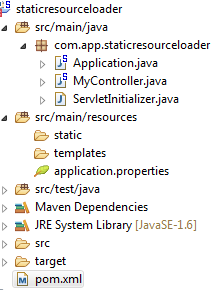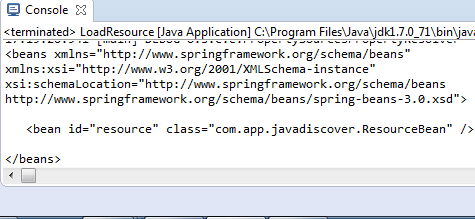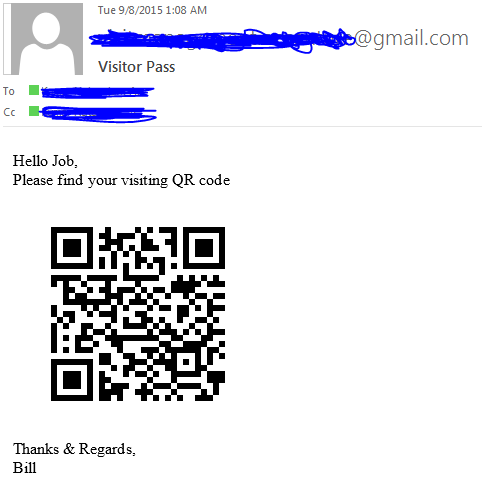In Spring we can configure static resources such as images, js, and, css files from specific locations under web application root, the classpath, and other locations. Even we can configure multiple locations to server different type of file.
An implementation of WebMvcConfigurer interface in WebMvcConfigurerAdapter abstract class with empty methods allowing sub-classes to override only the methods they're interested in. To achieve and serve static resources from different locations we need to extend WebMvcConfigurerAdapter class and need to @Override addResourceHandlers() method in our Application class.
Lets simple example to serve static resources like images and text files from different locations.
Here in this example we are loading images and text files from different locations like
- images from C://images
- text files from C://txtfiles
pom.xml
<?xml version="1.0" encoding="UTF-8"?>
<project xmlns="http://maven.apache.org/POM/4.0.0" xmlns:xsi="http://www.w3.org/2001/XMLSchema-instance"
xsi:schemaLocation="http://maven.apache.org/POM/4.0.0 http://maven.apache.org/xsd/maven-4.0.0.xsd">
<modelVersion>4.0.0</modelVersion>
<groupId>com.app</groupId>
<artifactId>staticresourceloader</artifactId>
<version>0.0.1-SNAPSHOT</version>
<packaging>war</packaging>
<name>staticresourceloader</name>
<description>staticresourceloader project</description>
<parent>
<groupId>org.springframework.boot</groupId>
<artifactId>spring-boot-starter-parent</artifactId>
<version>1.2.5.RELEASE</version>
<relativePath/> <!-- lookup parent from repository -->
</parent>
<dependencies>
<dependency>
<groupId>org.springframework.boot</groupId>
<artifactId>spring-boot-starter-security</artifactId>
</dependency>
<dependency>
<groupId>org.springframework.boot</groupId>
<artifactId>spring-boot-starter-web</artifactId>
</dependency>
<dependency>
<groupId>org.springframework.boot</groupId>
<artifactId>spring-boot-starter-ws</artifactId>
</dependency>
<dependency>
<groupId>org.springframework.boot</groupId>
<artifactId>spring-boot-starter-tomcat</artifactId>
<scope>provided</scope>
</dependency>
<dependency>
<groupId>org.springframework.boot</groupId>
<artifactId>spring-boot-starter-test</artifactId>
<scope>test</scope>
</dependency>
</dependencies>
<build>
<plugins>
<plugin>
<groupId>org.springframework.boot</groupId>
<artifactId>spring-boot-maven-plugin</artifactId>
</plugin>
</plugins>
</build>
</project>
application.properties
security.user.password=Efhj34tGVW
staticresourceloader.imageFileLocation.path:file:C:\\images\\
staticresourceloader.txtFileLocation.path:file:C:\\txtfiles\\
Application.java
package com.app.staticresourceloader;
import org.springframework.beans.factory.annotation.Value;
import org.springframework.boot.SpringApplication;
import org.springframework.boot.autoconfigure.EnableAutoConfiguration;
import org.springframework.boot.autoconfigure.SpringBootApplication;
import org.springframework.context.annotation.ComponentScan;
import org.springframework.web.servlet.config.annotation.ResourceHandlerRegistry;
import org.springframework.web.servlet.config.annotation.WebMvcConfigurerAdapter;
@ComponentScan
@EnableAutoConfiguration
@SpringBootApplication
public class Application extends WebMvcConfigurerAdapter {
@Value("${staticresourceloader.imageFileLocation.path}")
private String staticImageFilePath;
@Value("${staticresourceloader.txtFileLocation.path}")
private String staticTxtFilePath;
public static void main(String[] args) {
SpringApplication.run(Application.class, args);
}
@Override
public void addResourceHandlers(ResourceHandlerRegistry registry) {
registry.addResourceHandler("/api/image/**").addResourceLocations(staticImageFilePath);
registry.addResourceHandler("/api/txt/**").addResourceLocations(staticTxtFilePath);
}
}
ServletInitializer.java
package com.app.staticresourceloader;
import org.springframework.boot.builder.SpringApplicationBuilder;
import org.springframework.boot.context.web.SpringBootServletInitializer;
public class ServletInitializer extends SpringBootServletInitializer {
@Override
protected SpringApplicationBuilder configure(SpringApplicationBuilder application) {
return application.sources(Application.class);
}
}
MyController.java
package com.app.staticresourceloader;
import java.io.File;
import java.util.ArrayList;
import java.util.Collection;
import org.springframework.beans.factory.annotation.Value;
import org.springframework.http.HttpStatus;
import org.springframework.http.ResponseEntity;
import org.springframework.stereotype.Controller;
import org.springframework.web.bind.annotation.RequestMapping;
import org.springframework.web.bind.annotation.RequestMethod;
@Controller
public class MyController {
@Value("${staticresourceloader.imageFileLocation.path}")
private String staticImageFilePath;
@Value("${staticresourceloader.txtFileLocation.path}")
private String staticTxtFilePath;
@RequestMapping(value="/api/getImageList", method=RequestMethod.GET, headers="Accept=application/json")
public ResponseEntity<Collection<String>> getImageList(){
Collection<String> fileList = fileList(staticImageFilePath, "image");
return new ResponseEntity<Collection<String>>(fileList, HttpStatus.OK);
}
@RequestMapping(value="/api/getTxtList", method=RequestMethod.GET, headers="Accept=application/json")
public ResponseEntity<Collection<String>> getTxtFileList(){
Collection<String> fileList = fileList(staticTxtFilePath, "txt");
return new ResponseEntity<Collection<String>>(fileList, HttpStatus.OK);
}
public Collection<String> fileList(String folderPath, String type) {
File directory = new File(folderPath.replace("file:", ""));
File[] fList = directory.listFiles();
Collection<String> list = new ArrayList<String>();
for (File file : fList) {
list.add("http://localhost:8080/api/"+type+"/"+file.getName());
}
return list;
}
}

OUTPUT:












